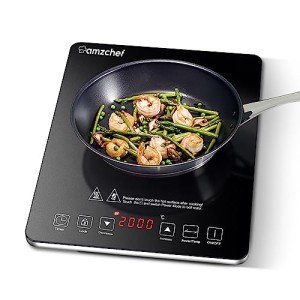Induction Hob Ratings: A Comprehensive Guide for Consumers
Intro
Induction hobs are ending up being an increasingly popular option for modern cooking areas thanks to their energy performance, accuracy cooking capabilities, and sleek designs. As culinary enthusiasts and home cooks alike look to upgrade their cooking devices, understanding various induction hob ratings ends up being pivotal. This article breaks down the essential features, advantages, factors to consider, and ratings of induction hobs, helping customers make informed decisions.
What is an Induction Hob?
An induction hob is a type of cooking surface area that utilizes electro-magnetic fields to heat pots and pans directly, rather than warming the cooking surface itself. This results in quicker cooking times and less heat loss, making induction hobs not just efficient but also more secure to utilize.
How Induction Cooking Works
- Electromagnetism: The induction coil beneath the ceramic surface area produces an electro-magnetic field.
- Direct Heating: When a suitable pots and pans is positioned on the hob, the magnetic field causes an electric current within the pots and pans, creating heat directly.
- Immediate Response: The cooking temperature can be adjusted quickly, providing higher control for the user.
Secret Features of Induction Hobs
Energy Efficiency
Induction hobs are frequently rated greater in energy performance compared to gas or standard electrical hobs. They can convert as much as 90% of the energy they consume directly into heat in the pots and pans, while gas hobs usually just convert around 40% to 55%.
Speed
Cooking with induction hobs is generally quicker. Water boils much faster compared to other cooking approaches, which can considerably lower overall cooking time.
Security
Induction hobs remain cool to the touch, reducing the threat of burns. Additionally, numerous models include automatic shutdown features, boosting safety for families with children.
Ease of Cleaning
The smooth glass surface area of induction hobs makes cleaning simple. Spills do not bake onto the surface area, simplifying maintenance.
Style and Flexibility
Induction hobs come in numerous sizes and styles, often offering extra features such as bridge functions (to connect 2 zones) or smart controls by means of mobile phones.
Understanding Induction Hob Ratings
Induction hobs are frequently ranked based on numerous criteria, consisting of power output, energy efficiency, security features, and user convenience. Given the rapid development in technology, ratings can fluctuate. Here's a table summing up the standards typically used:
| Feature | Ranking Scale | Considerations |
|---|---|---|
| Power Output | Watts (W) | Higher wattage normally implies quicker cooking times. |
| Energy Efficiency | A+++ to D | Ratings suggest effectiveness; A+++ being the most efficient. |
| Security Features | Yes/No | Ratings can show presence of innovation like automobile shut-off. |
| User Convenience | 1 (bad) to 5 (excellent) | Assessment of features such as timers, controls, and responsiveness. |
Popular Ratings and How to Interpret Them
When scouring reviews or product specifications, customers are likely to encounter ratings such as:
- Power Output (W): Often varies from 1300W to 3500W, depending upon the zone.
- Energy Rating: Indicates the total effectiveness, typically utilizing the A-G scale; the higher the letter, the more efficient the product.
- Temp Control: Refers to the hob's capability to maintain set temperature levels, frequently rated on a scale of 1 to 10.
- Alleviate of Cleaning: Ratings based upon materials utilized and surface design.
Advantages of Induction Hobs
Induction hobs use different advantages that ought to weigh greatly in a customer's decision-making process:
- Time-Saving: Due to their rapid heating abilities.
- Energy-Saving: Reduced energy intake when compared to gas or electrical models.
- Cooking Precision: Immediate modifications in heat levels enable for fragile cooking techniques.
- Eco-friendly: Lower energy usage adds to a lowered carbon footprint.
Factors to consider Before Purchasing an Induction Hob
While induction hobs have many benefits, it's important to consider the list below factors before buying:
- Cookware Compatibility: Only ferrous (magnetic) pans can be utilized. Unmagnetic pans will not work.
- Power Supply Requirements: Some models might require specific voltage requirements or dedicated circuits.
- Cost: High-end induction hobs include innovative features and greater price.
- Installation: May need expert installation depending on the design and cooking area setup.
Tips for Selecting an Induction Hob
- Evaluate Kitchen Space: Determine the size and setup that fits your cooking practices.
- Research Brands & & Models: Read reviews and comparisons to discern which brands and models offer the best features for your requirements.
- Concentrate on Features: Identify which features matter most to you, such as increase function, timers, or a touch control user interface.
FAQs
1. What kind of pots and pans can be utilized on induction hobs?
Induction hobs require pots and pans that is magnetic. This consists of cast iron, stainless steel, and some aluminum if they have a magnetic base. Items made from glass or copper may not function unless created particularly for induction.
2. How do I clean up an induction hob?
Cleaning is simple due to the smooth surface. Use a soft cloth or sponge with moderate detergent. Avoid abrasive cleaners that can scratch the glass surface area.
3. Are induction hobs noisy?
Some induction hobs can produce a humming or buzzing noise, specifically at higher power levels. This is usually due to the pots and pans vibrating. It's suggested to evaluate this in-store if noises are a concern.
4. Do induction hobs consume a great deal of electrical power?
Induction hobs are more energy-efficient than gas or standard electrical cooktops. While they do consume electrical power, the efficiency usually offsets general energy costs.
Induction hobs represent a combination of innovation and benefit that pleases modern cooking demands. By educating Induction Hob Tips about induction hob ratings and features, customers can with confidence pick the ideal model tailored to their culinary preferences. With developments in technology and a growing concentrate on energy efficiency, induction hobs are likely to stay at the leading edge of kitchen appliances for years to come.

